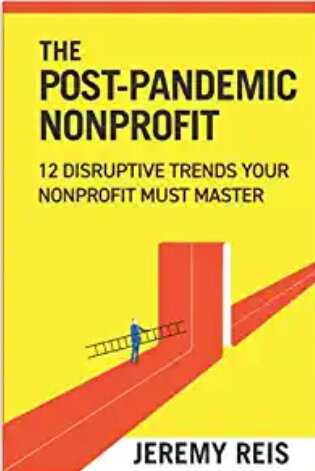The Post-Pandemic Nonprofit: 12 Disruptive Trends Your Nonprofit Must Master
The last eighteen months have seen dramatic and — not to wear out a word we've all seen too much of as of late — "unprecedented" change across all industries of the global economy. The United States is no exception, nor is the nonprofit sector. As charitable organizations contend with figuring out what the "new normal" looks like, Jeremy Reis, an experienced fundraising professional with a particular expertise in international development, offers to guide nonprofits on a path to post-pandemic success. While there is no denying that Reis has solid advice to give in The Post-Pandemic Nonprofit: 12 Disruptive Trends Your Nonprofit Must Master, given how quickly change can happen, the biggest question may be how long that advice will remain relevant and useful.
The Post-Pandemic Nonprofit contains exactly what it says on the tin. Reis has identified twelve strategies across three categories that he sees as key areas of investment for nonprofits to focus on as a way to survive and thrive in a post-pandemic philanthropic landscape: Who We Are (organizational identity), How We Operate (programming and functionality), and How We Grow (innovation and organizational development). While not all of these strategies are applicable to every nonprofit — and identifying his audience is something Reis struggles with throughout the book — the breadth of the suggestions means that most nonprofit professionals will be able to find something relevant and helpful to their organization's needs.
Before diving into the suggested strategies for surviving the current global circumstances as a nonprofit, Reis acknowledges how particular and peculiar those circumstances are. In fact, the first words of the introduction are, just on their own, "unprecedented times," followed by the question of how many times the reader has heard or seen that phrase since the start of the pandemic. He notes that as much of a cliché the phrase may have become, it is still in many ways the best — and often, only — way to describe the shared experience of nonprofit professionals around the world. The suggestions Reis offers are much less about how to mitigate damage from COVID-19 and much more about adapting to the new reality of a post-pandemic environment, seeing the necessary changes brought on by the crisis as opportunities to grow and innovate rather than obstacles to overcome.
Reis suggests that the extraordinary conditions all nonprofits are working under actually offer executives an opportunity to assess what is working well at their organizations and rework what isn't.
The strategies outlined in the first section, "Who We Are," are really about getting an organization back to basics and not letting pandemic circumstances distract from mission, programming, long-term strategy, or planned growth. Reis suggests that the extraordinary conditions all nonprofits are working under actually offer executives an opportunity to assess what is working well at their organizations and rework what isn't. Are all programs still serving the mission? Are they even viable? Does the mission itself still make sense? If the answer to any of those questions is 'no," he argues, now is the perfect chance to change things. He also emphasizes the need for proper risk management; if an organization didn't have a plan in place to respond to a drastic reduction in revenue before the pandemic, they should certainly know to invest in those strategies now. By making sure that mission, programming, and overall strategy are aligned and in service to one another, a nonprofit can ensure that it will have the foundation it needs to prosper and grow, no matter what global circumstances throw at it.
The section on "How We Operate" outlines suggestions for how to optimize the day-to-day processes and functionality of a nonprofit organization. Again, Reis focuses much of his attention on how to turn policies that organizations were forced to adopt to keep their staff and clients safe and healthy into opportunities for innovation and development. For example, Reis notes the number of nonprofits that have switched to a largely, if not entirely, work-from-home setup since last March. Now, with productivity levels equaling or exceeding those prior to the pandemic, those organizations are exploring making that decision permanent, potentially saving hundreds of thousands of dollars in rent or property taxes each year as they let leases run out and sell office space. He also notes how COVID-19 has made it essential for the nonprofit sector to focus on expanding accessibility options, and how that can be a powerful force for good moving forward. Reis highlights the increased use of tools like telehealth software and remote meeting technology and how these tools have extended the ability of many nonprofits to reach their target clients — while reducing overhead costs. Certainly, the pandemic has also made some programs and services more difficult to provide — but there is a silver lining to be found in the innovation that resulted from those challenges. As organizations rethink how to efficiently and safely deliver their services while keeping all parties safe, they're seeing more effective ways of running their programs.
It is that sense of innovation that backs the book's final section, "How We Grow." Reis takes particular care to highlight emerging technologies, how crucial they've become in a pandemic environment, and how they can be best utilized by nonprofits now and in the future to power positive, systemic change. While a lot of scholarship regarding technology over the past few years has discussed its potential pitfalls — the increased surveillance from our devices, the automation of previously manual tasks, etc., Reis focuses on the opportunity in these scenarios, not the challenges. When effectively used and transparently explained, he argues, technological innovations like artificial intelligence and virtual event spaces can streamline tedious processes and expand an organization's reach to a much wider audience.
The book does leave the reader with a few questions; the first is an issue of intended audience. Many of his examples come from some of the largest and most well-known nonprofits in the world, from Oxfam to the YMCA, and it often feels as though he is assuming the reader is an executive-level member of their organization. At other times, however, he feels the need to explain terms and concepts that even the least experienced nonprofit professional would be well familiar with. There is also the question as to whether The Post-Pandemic Nonprofit isn't jumping the gun somewhat. With the end of the pandemic not yet in sight — not in the United States and certainly not in the Global South, where vaccine rollout is still slow, and where many American-based nonprofits operate, including several that Reis himself cites — one can't help but wonder if this book is not a bit premature.
Still, overall The Post-Pandemic Nonprofit does a very solid job of looking ahead to the end of this global crisis and trying to predict the most important areas for charitable organizations to focus on so they can flourish. While not everyone will find all of Reis's suggestion relevant or applicable in the long term, every nonprofit professional should be able to find useful advice in this compact, accessibly written book.
Audrey Silverman is a fundraising professional working in the Jewish nonprofit sector.









